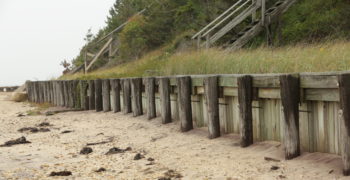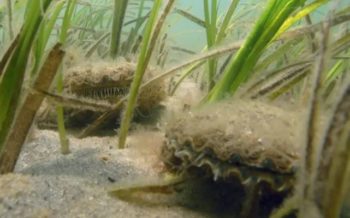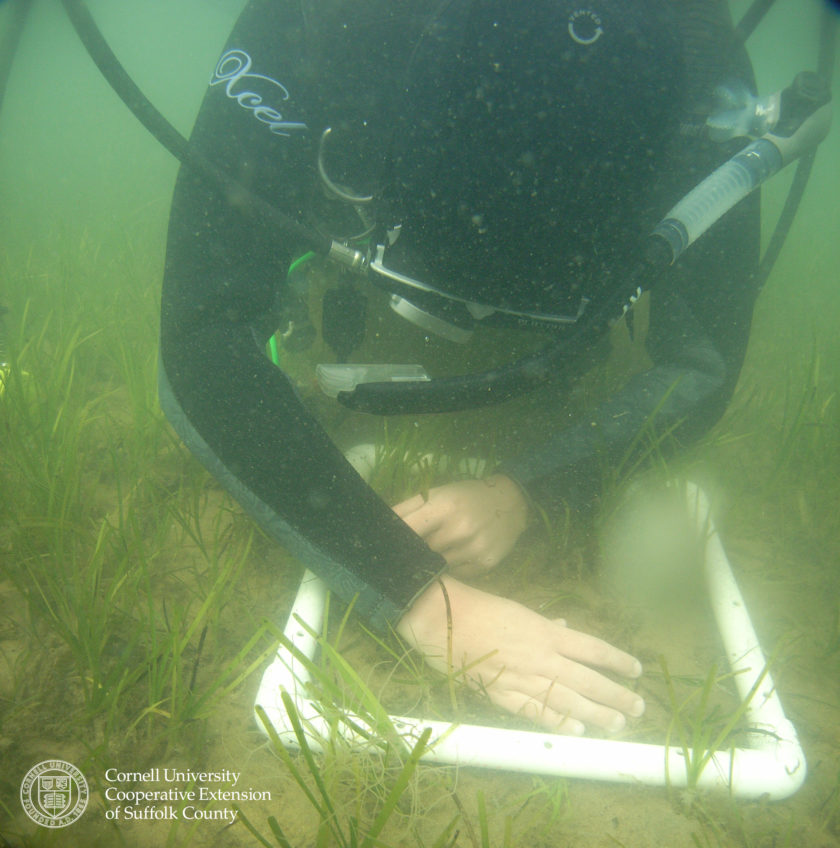In 1997 the Peconic Estuary Partnership Habitat Restoration Workgroup was formed and charged with identifying important Peconic natural habitats with enhancement or restoration potential, developing overall habitat restoration goals, and identifying and prioritizing potential restoration projects. The end product was the “Habitat Restoration Plan for the Peconic Estuary” dated December 2000. This Habitat Restoration Plan was subsequently updated in 2009, in 2017 and again in 2020. Over the years, the Peconic Estuary Partnership has completed projects to restore a variety of habitat types, including beaches/dunes, grasslands, diadromous fish habitat, eelgrass, and wetlands.
Peconic Estuary Partnership 2020 Habitat Restoration Plan
View Habitat Restoration Project Map
This project is based in partnership between PEP, The Nature Conservancy, The Town and Trustees of East Hampton as well as the regional group of experts, Salt Marsh Adaptation & Resiliency Teams, or SMARTeams. Over the past decade, SMARTeam members have piloted new techniques to address hydrologic dysfunction found within landscapes of marshlands of the North Atlantic Region.
Since 2016 Suffolk County Vector Control has been engaged with the Town of East Hampton, The Nature Conservancy, and several other community members to reduce the spraying of pesticides by removal of mosquito larvae in the Accabonac marsh complex. This community’s mosquito breeding program saved money, time, and pesticide exposure, and increased transparency between vector control and the community. This program’s data and Vector Control’s priorities are at the center of this design as the restoration approach strives to return the natural rise and fall of the tides, ushering in healthy native marsh vegetation to reduce the number of mosquito-breeding hotspot areas.
PEP and Suffolk County Health Services are currently leading the next phase of design and permitting. This is an opportunity for Accabonac Harbor to be exemplary in pushing forward the development of new and novel restoration approaches in order to combat sea level rise. The regional group, SMARTeams, has developed these methods which introduce an alternative to traditional high disturbance restoration.
Currently, contracts are executed & stakeholder meetings and workshops are in progress. Please reach out to jade.blennau@stonybrook.edu if you are interested in this project's progress.
The Upper Mills Dam is the next major barrier to fish passage on the main stem of the Peconic River. In addition to the dam, USGS maintains a concrete weir two-hundred and fifty (250) feet downstream of the dam in order to measure the stage and discharge of the Peconic River, which also impedes fish passage. A feasibility and alternative analysis for fish passage at the Upper Mills Dam was completed in 2011. PEP is currently contracting with L.K. Mclean Associates P.C. to complete the engineering design and permitting services for construction of a fish passage at the Upper Mills Dam and Weir. This project will open 40 acres of historic spawning and maturation habitat for diadromous fish. The fish passage engineering design and permitting work is complete.
PEP is working with partners to secure construction funding for this project.
Click here to Learn about PEP’s Progress in Diadromous Fish Habitat Restoration.
In 2019 PEP completed a conceptual design, with Land Use Ecological Services, Inc., for the priority habitat restoration project at Meetinghouse Creek, Riverhead, NY. Click here for the Meetinghouse Creek Wetland Restoration/ Construction Conceptual Design Plan.
This site is located at a large wetland area that forms the headwaters to Meetinghouse Creek in Riverhead, NY. Meetinghouse Creek is listed as an impaired waterbody on the NYSDEC Priority Waterbodies List. The wetland vegetation at this site is dominated by Phragmites.
The conceptual design recommendation is to construct a 1.2-acre stormwater wetland to treat stormwater runoff in the 5.6 acre contributing watershed. This will improve water quality in the downstream wetland and surface waters. Additionally, it will greatly increase the ecological quality of the habitat and improve plant and wildlife diversity.
Engineering Designs and Permitting for the habitat restoration project has been completed. Interfluve and Land Use Ecological Services, Inc., and Town of Riverhead completed the Engineering Designs, Permitting services, as well as EPA QAPP.
Meeting House Creek Wetland and Habitat Restoration
Meetinghouse Creek Factsheet April 2024.docx
In 2019 PEP completed a conceptual design, with Land Use Ecological Services, Inc., for the priority habitat restoration project at Narrow River Road, Southold, NY. Click here for the Narrow River Road Wetland Restoration Conceptual Design Plan.
Narrow River is a tributary of the Peconic Bay and flows south from the Town’s Whitcom Marsh Preserve under Route 25 and along the eastern side of Narrow River Rd in Orient, NY. An earthen dam was constructed after the 1938 hurricane to prevent tidal flooding of the lands north of the dam. The westernmost section of the dam blocked the tidal flow from Narrow River to the large meadow area north of the dam known as Broad Meadows and Whitcom Marsh Preserve north of Route 25.
Remediation of the culvert and earthen dam is needed to improve the tidal exchange throughout the extent of the river and increase the salinity of the river to promote the re-establishment of native vegetation and important waterfowl and wading bird habitat. The potential extent of the restoration area is 80 acres. PEP assists partners in securing funding for engineering design plans and construction.
Paul Stoutenburgh Preserve is a Town owned 52 acre nature preserve on the west side of Arshamomaque Pond with an adjacent 7 acre County owned preserve, Arshamomaque Preserve. Several areas along the shoreline and interior have pockets of invasive Phragmites australis resulting in low quality wetlands. Invasive mile-a-minute weed has become established and is rapidly increasing in areas adjacent to tidal and fresh water wetland areas. The project site was nominated by the Town of Southold to be included in the Peconic Estuary Program Habitat Restoration Plan in 2013 and the project was prioritized for habitat restoration in 2016. Habitat restoration is recommended and is anticipated to involve the removal of the invasive species using currently accepted removal and restoration practices, and changes to drainage infrastructure in the area to make conditions less suitable for invasive vegetation.
The Paul Stoutenburgh Habitat Restoration Project is ongoing. The contractor has completed an assessment of the hydrology of the southwest portion of the Paul Stoutenburgh Preserve and presented findings in stakeholder meetings and Southold Town Trustees. These hydrological plans and alternatives will be used for the Town Engineering Department to make data-driven decisions for implementation on their property. Engineering plans are in process of being submitted for permits to upgrade and right size the culvert to hydrologically repair flow and restore wetland area.
The PEP is working with the NYSDEC and SUNY Stony Brook to analyze spatial and temporal trends in the Peconic Estuary finfish trawl survey dataset, and develop risk metrics from ecological relationships for the Peconic Estuary that examine whether local and regional environmental changes have increased the vulnerability of individual finfish and mobile invertebrate species, community assemblages, and ecosystem processes.
The ECOSIM is a quantitative modeling framework that can represent all major ecosystem functional groups and can be used to identify and assess structural changes in the ecosystem in response to environmental change. The proposed study will identify vulnerable species, critical habitats, and ecosystem properties within the Peconic Estuary. This information has direct application to decisions affecting the use, management, and conservation of the natural resources in the bay.
A SUNY Stony Brook is advertising for a post-doctoral position currently to complete the work. The expected completion period is March 2023.
Ground truthing for the 2020 Hardended Shoreline Assessment is ongoing in partnership with Cornell Cooperative Extension. 
In partnership with Bradley Peterson, PhD. SoMAS, Stonybrook University and Joseph Tamborksi PhD., Department of Ocean & Earth Sciences, Old Dominion University
Restore America's Estuaries 2022 Coastal Watershed Grant Funding:
Rising water temperatures are restricting seagrass coverage to areas of increased oceanic
influence throughout the northeastern US. Resource managers are faced with the reality that
climate change is rendering many current restoration strategies ineffective. This project will
demonstrate the use of groundwater as thermal refugia in an emerging restoration strategy.
Using assessments of key parameters (e.g.: radon, groundwater discharge) and novel seagrass
transplant techniques, we will test and demonstrate an approach that has the potential to
transform this type of eelgrass restoration. Doing so will make such projects more predictable
and effective, allowing for larger-scale efforts in estuaries impacted by groundwater discharge.


